Telkom, South Africa's state-owned telecommunications company, has recently declared and completed a $357 million sale of its cell phone towers. 6200 mobile towers make up Telkom's vast portfolio of communication infrastructure, which is managed and operated by Swiftnet, owned by Telkom. The buyers, UK private equity firm Actis and Royal Bafokeng Holdings, an investment division of the Royal Bafokeng House, hold a 70/30 ownership split.
It appears from observation that mobile providers are increasingly selling off their cell phone towers, and Telkom is not the only one doing this.
Towers-as-a-Service
- In 2018, American Tower Corporation acquired Telkom Kenya’s 723 cellphone towers.
- 2011 saw Cell C also sell 3200 of its towers to American Tower Corporation for $430 million.
- Bharti Airtel, completely sold off its 8300 cell phone towers in markets like Tanzania, Madagascar, Malawi among many others, over a 5 year period for around $2 billion.
- Following an initial public offering (IPO) on the London and Johannesburg stock exchanges, Helios Towers raised approximately $2 billion. The company currently operates 1676 towers in the Democratic Republic of the Congo, 394 towers in Congo Brazzaville, 3800 towers in Tanzania, and 750 towers in Ghana, all of which were acquired from Airtel, Vodacom, Millicom/Tigo, and Zantel.
- Africa’s largest cellular towers company, IHS towers, owns an impressive portfolio of 14,413 towers in Nigeria. IHS owns further towers in Rwanda and Zambia (2382 towers) ,Cameroon and Ivory Coast (3757 towers) purchased from mobile operators including Etisalat, MTN, Visafone, Airtel and Orange.
Towers disinvestment
Digital infrastructure is big business in Africa. Housing more than 120,000 towers and plenty more under construction, tower operators like, Helios Towers, Eaton Towers, IHS Towers and ATC generate billions through renting and leasing towers to mobile operators. One tower can house as many as three tenants at a go.
Then, it's interesting to wonder why, given how profitable the industry is, mobile operators are offloading their tower infrastructure. And why, as a mobile operator, would you sell your towers when towers are the infrastructure that enables an operator to offer its connectivity services and packages?
We are pivoting from a telco to a customer-centric digital lifestyle company. We are simplifying, focusing, leveraging, and excelling- Cell C's CFO, Zaf Mahomed, on the Turnaround Strategy
In his address at the Gordon Institute of Business Science (GIBS), former CFO Zafar Mohamed discussed Cell C's turnaround strategy to recapitalize itself. Mohamed outlined a four-pillar plan for the company's turnaround, with a focus on operational efficiency.
Cell C reduced capital expenditures by selling off non-essential assets like towers and concentrating on core company operations. Mohamed said, "An asset-light infrastructure model leading to improved profitability." MTN and Telkom both highlighted this as justification for their disinvestments.
Power Outages
The maintenance and profitability of tower infrastructure is severely impacted by load shedding and lengthy power outages that occur across the continent.
As an industry, we've probably invested over R10 billion. At Vodacom we've invested R4bn in the last four years, and then another billion this year. Both into batteries, and of course we're getting an incremental cost in fuel, and as the fuel prices move that all has an impact on us - Vodacom's CEO, Shameel Joosub, on loadshedding expenses.
There are 56 power outages in Sub-Saharan Africa annually, with an average duration of 4 hours. Since 2007, South Africa has been dealing with a serious energy crisis, marked by frequent load shedding bouts during which power is routinely switched off to various locations for 2-4 hours at a time (an average total of 118 hours annually).
Nearly 33 power outages each month, or about 394 outages annually, are experienced in Nigeria, the third greatest number worldwide. In comparison, this picture shows how practically difficult and expensive it is to maintain uptime, as the average American endures less than 10 hours of power outages annually.
Hefty maintenance costs are spent by mobile providers to maintain backup power infrastructure. Selling off their towers and passing on that cost to independent tower companies to concentrate on their core business has become a necessity to ensure cost-effectiveness and profitability.


